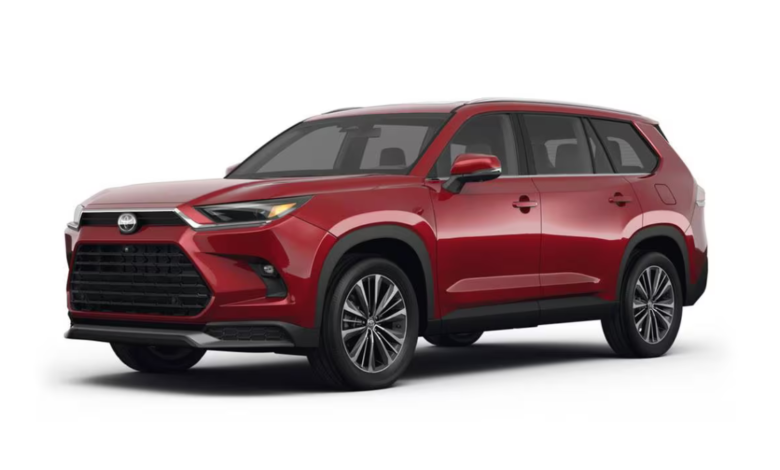
(Toyota Grand Highlander)Toyota unveiled the Grand Highlander, a three-row SUV that builds on the popularity of its Highlander model, all new for 2024. The Grand Highlander seems to have a bright future ahead of it, given that the smaller Highlander debuted in 2001, and the brand has sold 3.3 million units in the United States (and about 250,000 units in 2022 alone). The Grand Highlander, a crammed three-row SUV highway car with a capacity for seven or eight people, has much to offer, including good performance, a clean appearance, and hybrid fuel efficiency.
Although almost everything about the Grand Highlander is new, it is constructed on the same chassis as the standard Highlander by Toyota. It comes with three interchangeable powerplant options and three different trim levels. Compared to the regular Highlander, it is 2.3 inches wider, 2.0 inches higher, and 6.5 inches longer, which results in a roomy third row. Toyota pushed the Grand Highlander further than previous designs, and the Limited and Platinum interiors hint toward Lexus territory. It’s unmistakably Toyota and doesn’t go into edgy aesthetics.
The Grand Highlander is competitive with the Nissan Pathfinder, Jeep Grand Cherokee L, Mazda CX-90, and Volkswagen Atlas. Families of all sizes will undoubtedly be pleased with the Grand Highlander, the most spacious of the bunch regarding cargo dimensions alone. The Grand Highlander, which starts at $44,405, is more expensive than the Nissan but comparable to the Jeep and Mazda. The Grand Cherokee L is even more powerful at 6,200 pounds, but the Pathfinder’s 6,000-pound tow rating surpasses the Toyota’s by 1,000 pounds.
Three different powertrain options are offered for the 2024 Grand Highlander: a standard 2.4-litre turbocharged gas engine, a 2.5-litre fuel-efficient hybrid, and the performance-oriented, 362-horsepower Hybrid Max. The top-tier Platinum trim comes standard with all-wheel drive (AWD), while the XLE and Limited grades may be ordered with front-wheel drive or all-wheel drive (AWD). Even though none of them are hot rods in the vein of the BMW X7, they are all competent drivers, and the Hybrid Max is so fun that the other two are only distant second choices. Toyota performs exceptionally well with hybrids; the well-known electric motor hum doesn’t change.

Combining a front-wheel drive vehicle with the turbo gas engine in the Limited or Platinum trim results in a combined fuel efficiency of 22 mpg, at the bottom of the class. That’s not as excellent as the CX-90 plug-in hybrid, which gets 25 mpg, but it’s still marginally better than the Grand Cherokee L with four-wheel drive and a V6 gas engine, which gets an estimated 21 mpg combined. If you value fewer miles per gallon, consider the Grand Highlander XLE hybrid, which achieves an even more remarkable 34 mpg combined.
While Toyota’s basic warranty (three years or 36,000 miles) isn’t as good as that of Kia or Hyundai, it comes with two years of complimentary scheduled maintenance—something neither Nissan nor Mazda offers. An eight-year, 100,000-mile guarantee covers the hybrid components of Hybrid and Hybrid Max Grand Highlanders. On the Grand Highlander, Toyota’s Safety Sense 3.0 is standard equipment and offers a comprehensive suite of active safety features to all trim levels. We anticipate it will do well in crash testing and that many will soon be seen on the road.
What’s New
- This new model for 2024 adds a genuinely adult-sized third row to the Highlander series for the first time, although it is based on the smaller Highlander.
- With a starting point of XSE and a plethora of standard features, the Grand Highlander is not available at the lesser trim levels of the ordinary Highlander.
- Despite having the same name as the regular Highlander, the Grand Highlander is significantly more than that SUV and has no outward or interior design elements in common.
- Three different powertrain options are available: a four-cylinder gas turbocharged engine and two more robust hybrids.
- Regarding passenger and cargo capacity, the Grand Highlander is on par with or superior to several former class leaders, such as the Volkswagen Atlas.
Pros & Cons
Pros
- Variety of powertrains
- Third row at adult size
- Driver-assist technology that is generous
Cons:
- Tiny volume knob
- restricted view out of the rear window, mainly when people are occupying the third row
Performance: Toyota Grand Highlander
Toyota chose to provide the Grand Highlander with various powertrain choices, as is customary for the brand. The new car may have a standard 2.4-liter turbocharged four-cylinder gas engine that produces 265 horsepower, delighting gas-only enthusiasts. Toyota claims it takes 7.5 seconds to accelerate from a halt to 60 mph.
The carmaker is a master at hybrid technology, however, and even with the 2.5-litre hybrid engine’s 245 horsepower and 7.8-second zero-to-60 speed, it outperforms the gas version in terms of fuel economy.
The Hybrid Max variant is the fastest and quickest, with a substantial electric motor and a 2.4-litre engine for power. The robust 400 lb-ft of torque and 362 horsepower allow the Hybrid Max to accelerate from a halt to 60 mph in 6.3 seconds. With a maximum towing capability of 5,000 pounds, the Hybrid Max is undoubtedly the most performance-oriented variant; the hybrid model is only capable of 3,500 pounds.
That’s about the same as its rivals in the class and three-row vehicles like the Kia Telluride, while the Nissan Pathfinder can tow up to 6,000 pounds, and the Jeep Grand Cherokee L can pull a maximum of 6,200 pounds. Transporting a camper, a medium boat, or a few snowmobiles in the Grand Highlander is possible.
The Grand Highlander is a pleasant car with its smooth, hassle-free ride, strong merging and passing abilities, and three engine choices. All-wheel drive, gas-powered, and Hybrid Max vehicles come with three extra modes for mud and sand, rock and soil, and snow in addition to the three standard drive modes (sport, eco, and regular). Automatic transmissions with eight speeds are standard on all Grand Highlanders.
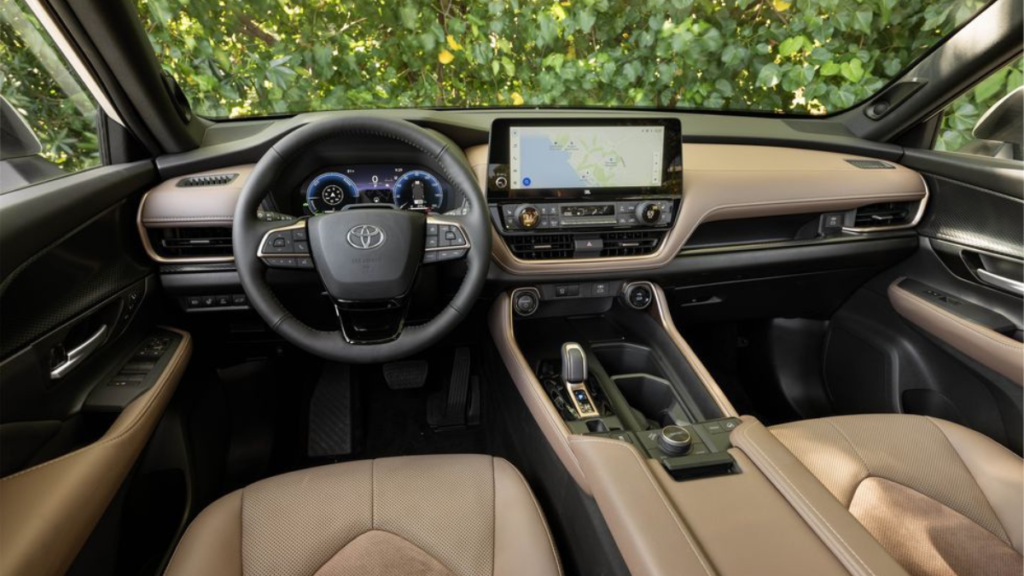
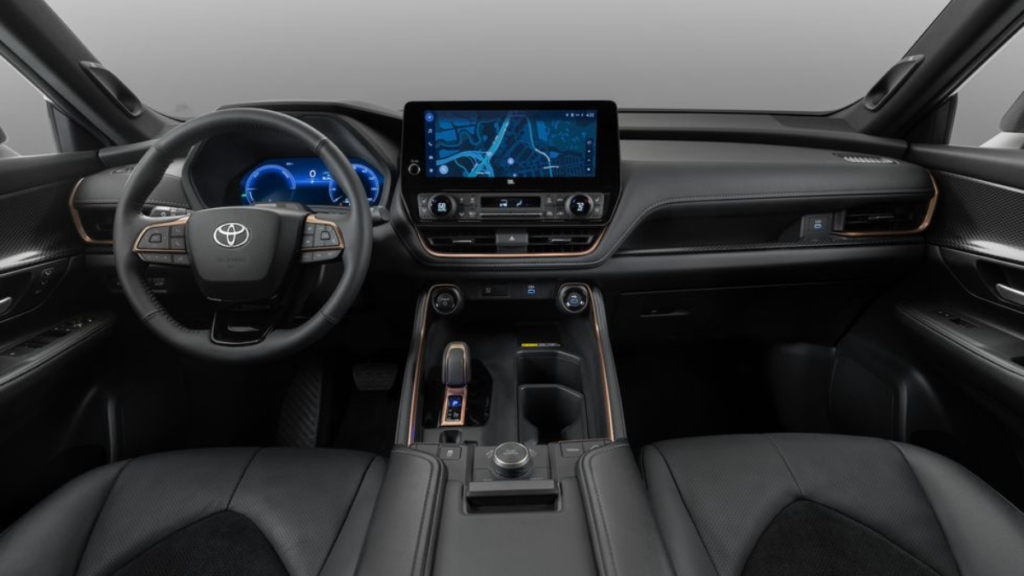

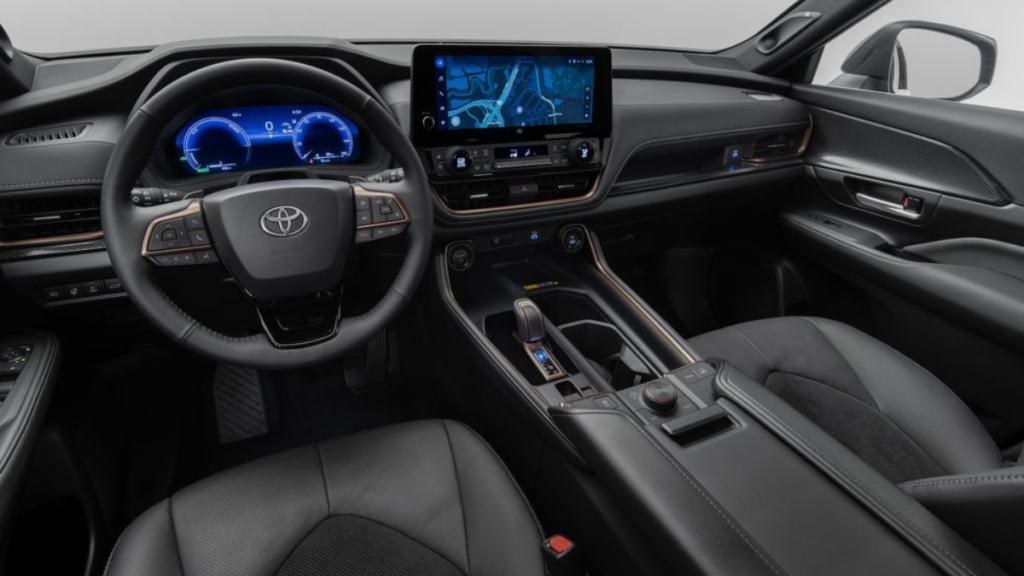
Fuel Efficiency: Toyota Grand Highlander
Your chosen model will depend on how vital fuel economy is to you. The entry-level gas-powered Grand Highlander Limited and Platinum grades, with all-wheel drive, get 22 mpg, while the basic model manages one more for 23. Hybrid Max models have a middle-of-the-pack mileage of 27 miles per gallon.
The Grand Highlander hybrid, which gets 33 to 34 miles per gallon (Limited and Platinum compared to the somewhat more efficient XLE), is at the top of the fuel chain. The accuracy of these EPA ratings will be ascertained by longer-range testing, and previous testing has shown that Toyota cars are pretty accurate.
This contrasts with the gasoline-powered model’s 24 mpg. For a 201-inch long, three-row family SUV, that’s a remarkable figure, considering many competitors in the class only get 23 mpg overall.
In contrast, the plug-in hybrid Mazda CX-90 gets 25 mpg combined and 26 miles on electricity alone. The Jeep Grand Cherokee L gets a less-than-impressive 21 mpg, while Nissan’s Pathfinder achieves 23 mpg. The combined fuel economy of the VW Atlas and Honda Pilot is between 20 and 22 mpg.
Driver assistance and safety:
Toyota has consistently received high ratings from the Insurance Institute for Highway Safety (IIHS) and the National Highway Traffic Safety Administration (NHTSA) for safety and driver-assist technologies. Although it hasn’t been rated yet, the 2024 Toyota Grand Highlander will fare well. As a benchmark, the IIHS has already designated the 2023 Highlander as a Top Safety Pick+, even though this year has seen a noticeable increase in criteria.
The Grand Highlander now has a comprehensive array of Toyota Safety Sense technology, including the most recent TSS 3.0 upgrade. The new SUV comes equipped as standard with blind spot monitoring with rear cross-traffic alert, lane tracing assist, automatic high beams, pre-collision system with pedestrian detection, lane departure alert with steering assistance, and a feature called Proactive Driving Assist that applies light steering and braking when approaching a sharp curve or a moving object.
The driver-assist technology on the Grand Highlander is pleasantly subtle. Similar configurations may be available from other companies; however, driving in another SUV is jerky or annoying. Not with this new SUV, though. The overall experience is predictable in the best ways, the cruise control is easy to set and intuitive, and the driving is competent whether the driver aids are used.
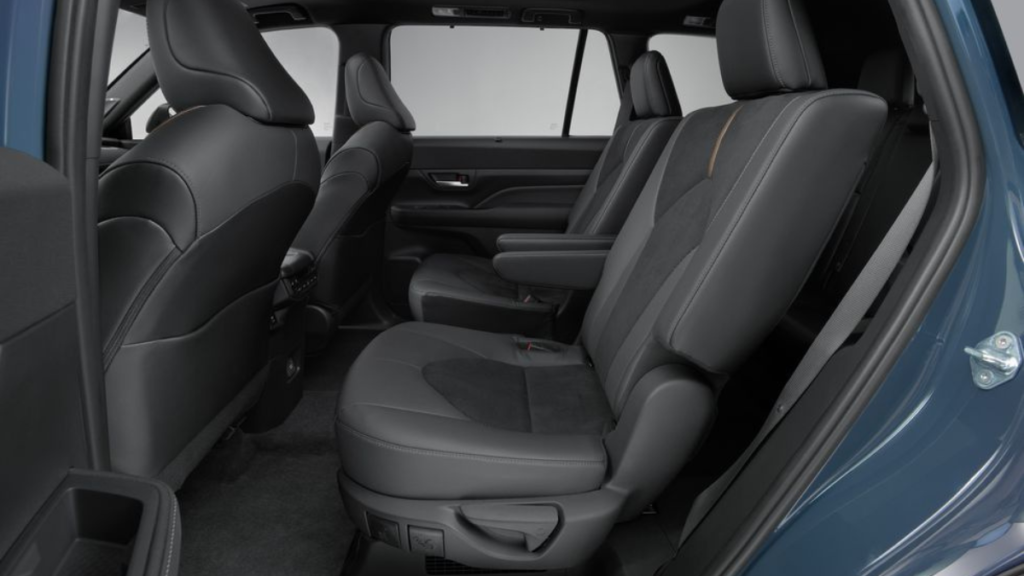
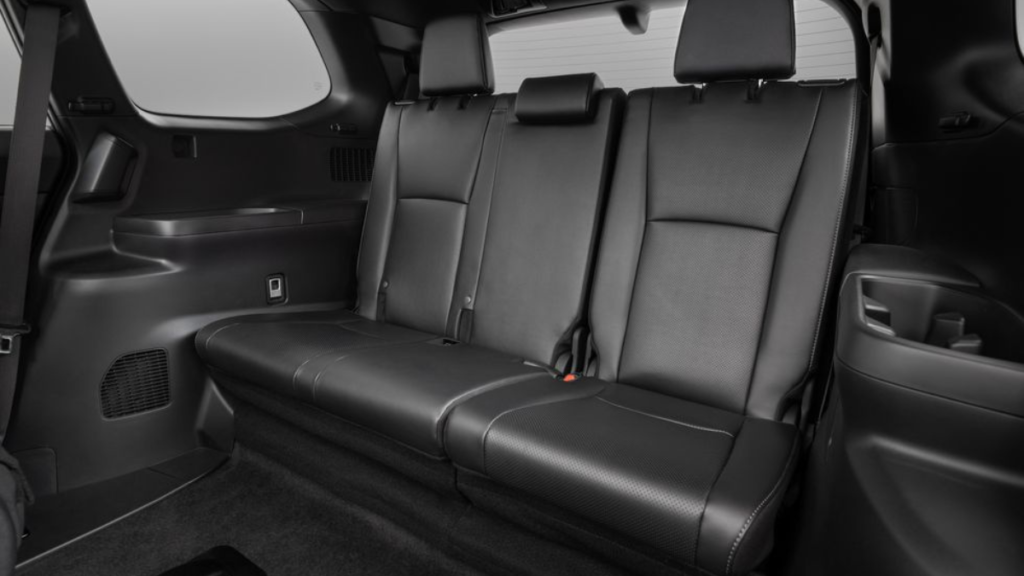
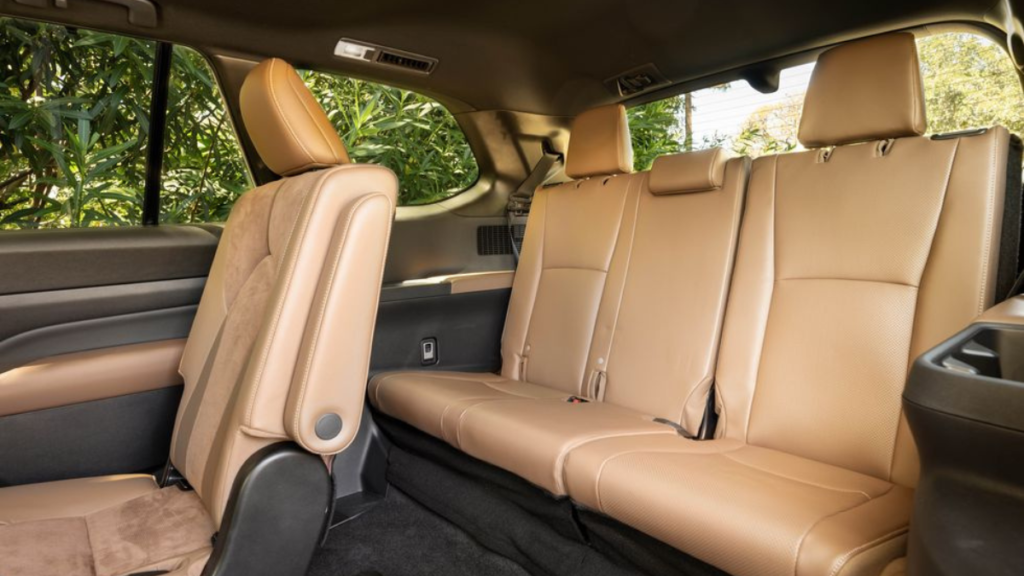
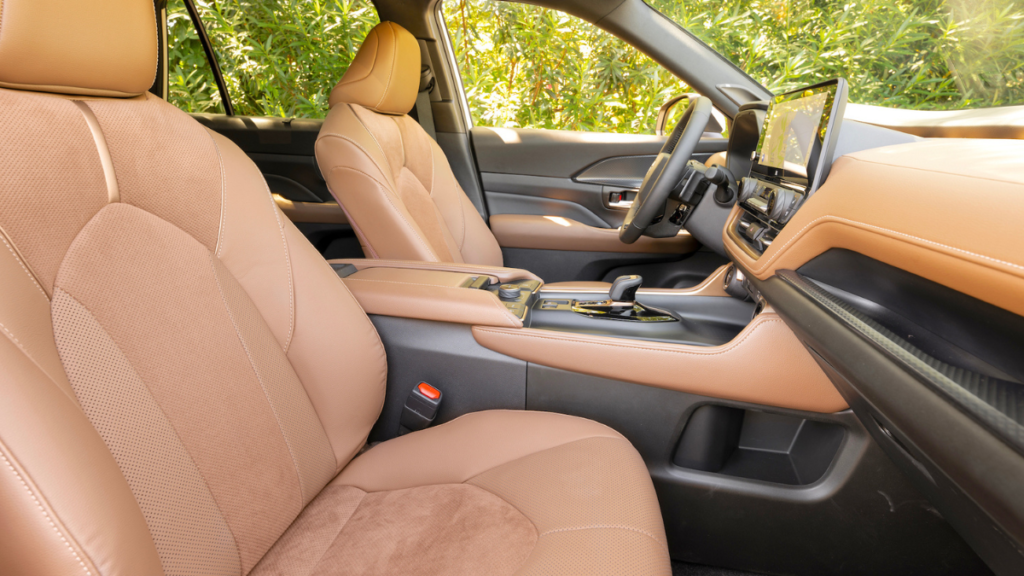
Coziness & Space:
This car’s unibody architecture makes it feel and drive like a smaller SUV. Despite being 6 inches longer than the Highlander, it parks just as effortlessly because of its broad body, allowing plenty of elbow space without crowding against painted parking lines. Standard heating is included with front-row seats, while higher trims gradually add ventilation and warmth to the first two rows.
Even those six feet tall will have enough space in the third row (33.5 inches), falling just short of the class-leading Atlas by 0.2 inches, although the padding on the seats is not as good as it might be. Tall people may find a lengthy car journey uncomfortable, but short to medium-length excursions lasting a few hours are ideal. Those who are smaller may also benefit from the design, which puts visibility over the windscreen.
The Grand Highlander’s third row has 5.5 inches more legroom than the Highlander’s, turning a much too cramped area into a respectable one. That is five inches more roomy than the third row of the Pathfinder and just marginally smaller than the considerably bigger Toyota Sequoia SUV. The Grand Cherokee L from Jeep is less than 30.3 inches, but the Mazda CX-90 is 30.4 inches longer.
Infotainment: Toyota Grand Highlander
A 12.3-inch touchscreen that comes standard on the Grand Highlander is combined with Toyota’s most recent infotainment system, initially introduced on the 2022 Lexus NX. While it would be wonderful if the radio/satellite favourites list appeared independently of the search button, voice commands with a callout of “Hey, Toyota” function nicely. This infotainment system is a significant improvement over the old one. The Grand Cherokee L from Jeep and the CX-90 from Mazda include a 10.3-inch display. The Nissan Pathfinder’s 8-inch touchscreen is modest, and its visuals aren’t as good as the other models.
As one would anticipate, Bluetooth, Apple CarPlay, and Android Auto are all standard. The standard Grand Highlander has six built-in speakers, but an optional 11-speaker JBL audio system sounds clear and sharp. Although it’s not as powerful as the Grand Cherokee L’s luxurious McIntosh audio system, it’s nonetheless of excellent quality.
Beginning with the basic XLE, a Qi wireless charger is included as standard equipment. The Grand Highlander has seven USB-C connections, two of which are in the third row.
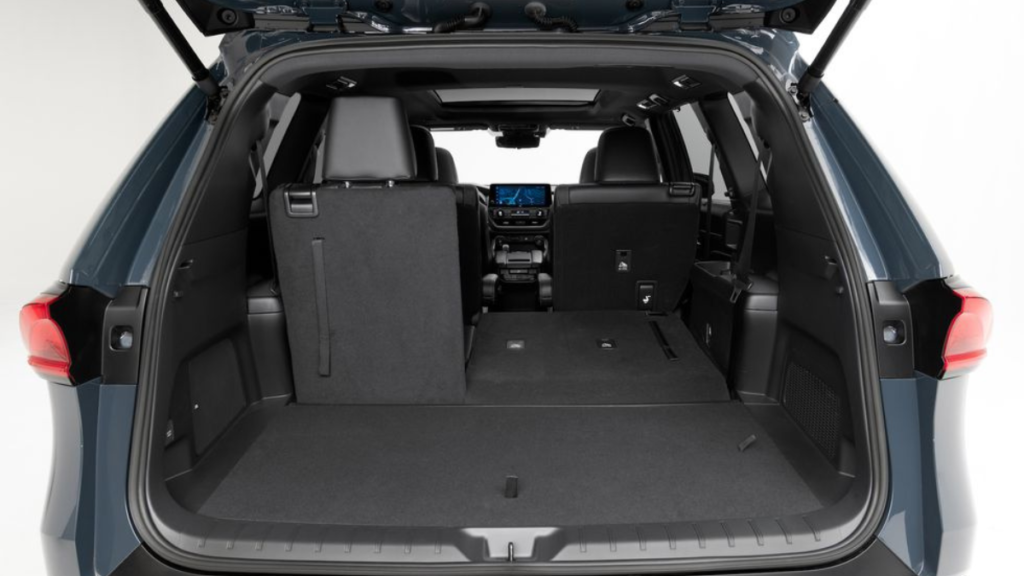

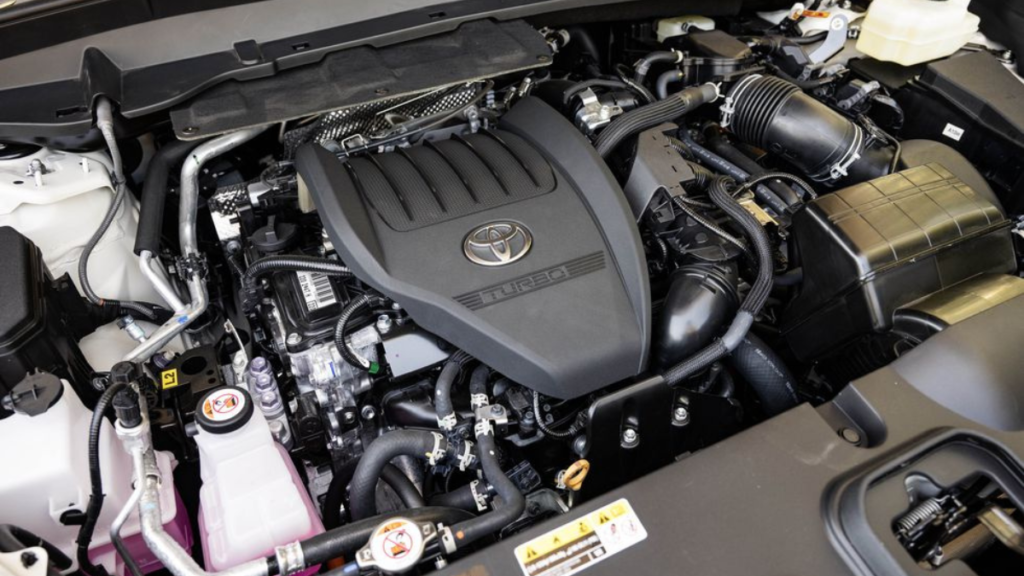
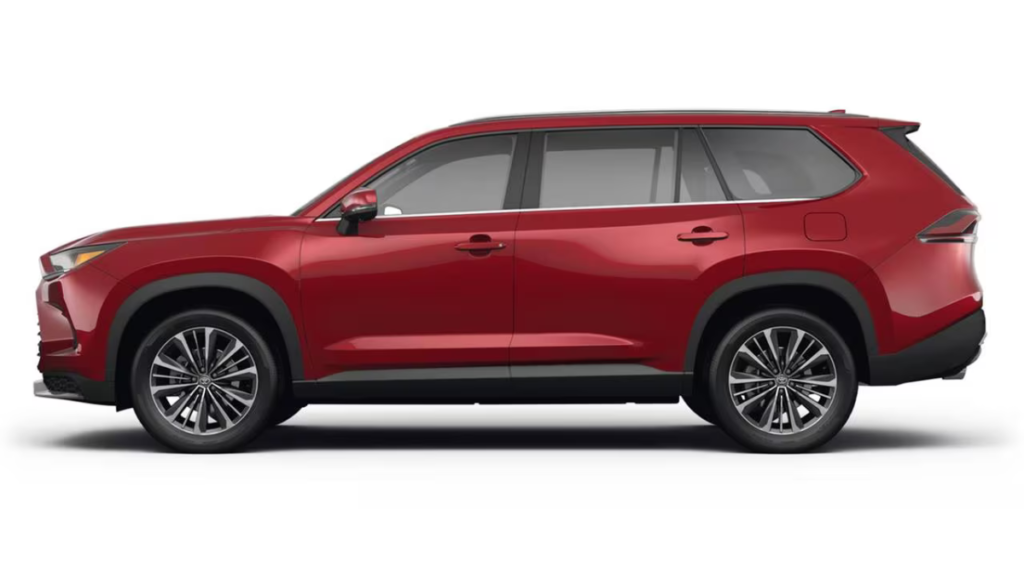
Storage & Cargo Space:
Even with all the seats folded up, Toyota overcame space constraints and built a vast cargo area throughout the Grand Highlander, which can hold seven compact rollaboard luggage. The size increases to 57.9 cubic feet from 20.6 cubic feet when the third row is folded. Upon folding every seat, an astounding 97.5 cubes are obtained. This is no small achievement since it matches or surpasses the formerly class-leading Atlas (20.6, 55.5, and 96.8 cubic feet in the same measures).
Tiny storage is ample and adaptable. Removing the central console in the second row between the captain’s seats to accommodate a small cooler or a basket filled with plush toys is possible. Not to mention the thirteen cupholders strewn around the cabin.
The number of cup holders and the upright door pocket space for drinks will be appreciated by drivers who bring coffee, water, or weary kids along for the ride. The two cup holders up front and a more extensive water bottle compartment are much-loved design elements.
Design: Toyota Grand Highlander
Along with the Grand Highlander came two new exterior colours: Storm Cloud, a thunderstorm-inspired shade that falls halfway between blue-grey and blue-green, and Coastal Cream, a delicate ecru that has a less intense metallic look than Blizzard White Pearl on earlier models. The Grand Highlander has a sleek appearance from the exterior thanks to its “hammerhead” grille and flowing lines. Its design is not very striking, but it is in keeping with the Toyota SUV portfolio and fit for the brand. The Hybrid Max versions have attractive twin exhaust tips punctuating their silhouette on the back.
Inside, the Hybrid Max Limited models’ bronze highlights are tastefully understated, giving the trim a touch of refinement. All in all, Toyota chose premium materials, and the fit and finish are exact and long-lasting.
On versions without the digital rearview mirror, sight is slightly limited due to the thicker D-pillar and smaller rear window, but the large windows make up for that shortcoming. Technological advancements, such as cross-traffic alerts and blind-spot monitoring, also increase safety.
Is the 2024 Toyota Grand Highlander Worth it?
Toyota knows it has to go above and beyond to compete in this market and this sector, so it has crammed this SUV with many amenities, spaciousness, and well-considered details. That’s why the Grand Highlander, which starts with the basic XLE model, which is generally mid-grade for Toyota, is packed with goodies and a comprehensive suite of driver-assist technologies.
The XLE grade has a capacity for seven or eight people, depending on whether you choose the centre bench seat or the captain’s chairs, and it starts at $44,405 (including destination taxes). Along with heated front seats, 18-inch wheels, second-row sunshades, control front and passenger seats, six USB-C outlets, one charging port, a wireless charger, a power liftgate, and an auto-dimming rearview mirror, it also comes with a sizable amenity package.
The Grand Highlander moves up with 20-inch wheels that liven up the outer appearance in the Limited model ($49,195). The front seats now have ventilation controls, while the middle row has heated seats, ambient lighting, a hands-free liftgate, and a heated steering wheel. At this level, a handy household-style outlet is also included as standard.
With the same 20-inch wheels as the Limited, the $59,460 Platinum model sits at the top of the Grand Highlander food chain. With its panoramic sunroof, the SUV’s interior seems lighter and roomier than its more opulent version. Additionally, the seats in the second row are vented and chilled. There are no facilities for you, third row. Sorry.
The Limited model with the hybrid drivetrain is your best option if you’re looking for a comfortable ride with excellent fuel efficiency, costing $52,395. A gas-only version of the Grand Highlander is available, but is it essential? Toyota is a leader in the hybrid industry and will only gain stronger in it. For a little less than $3,000 extra, the Hybrid Max combined with the Limited trim is an excellent option for anyone who wants more power and torque.

How Much Does Toyota Grand Highlander Insurance Cost?
Since the Grand Highlander is a brand-new vehicle, insurance information is unavailable. However, insurance prices are expected to be comparable to the standard Highlander. An average yearly premium for a Highlander XSE for a typical 30-year-old female driver with a spotless record is $1,994. However, this figure applies to all 50 states. This is in contrast to the VW Atlas SEL ($1,978), Nissan Pathfinder SV ($2,103), and Jeep Grand Cherokee L Altitude ($ 034).
Toyota Grand Highlander Generations
First Generation
2024 to Present
Although the Grand Highlander and the popular midsize Highlander share a name, platform, and specific engine technology, they vary significantly in other aspects. The Grand Highlander is a bigger version of the Highlander. With its sleeker and more sophisticated external and interior design than the standard model, the Grand Highlander targets the giant midsize three-row vehicles, such as the Volkswagen Atlas and Honda Pilot.
Toyota went above and above to make the Grand Highlander more roomy, responding to complaints that the standard Highlander’s third row is too tiny for anybody except young children. Moving to a vast, full-size SUV like Toyota’s own Sequoia would be best to acquire more space than its almost class-leading third-row legroom and load capacity. With its superior power and class-leading fuel economy, the Hybrid Max outperforms the other two four-cylinder powertrains.
Verdict
With its adult-sized third row, the new Toyota Grand Highlander fits nicely between the standard Highlander and the full-size Sequoia. The Grand boasts the most excellent features from the rest of the Toyota SUV series since the carmaker has learned a lot from its mistakes and successes. The 362-horsepower Hybrid Max, priced at $44,405 for the gas-only variant, is the true jewel in the powertrain selection. Families will like the Grand Highlander’s excellent handling, roomy cargo hold, and capacity for up to eight people. Even before it is released onto American roads, this SUV exudes success.




